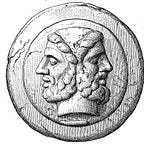Ultimate Stablecoin Classification
Crypto-currencies are infamous for their volatility. Stablecoins mitigate this crypto-volatility risk, as the value of stablecoin is (almost always) equal to a targeted fiat currency (USD, EUR, CHF, …) or a basket of currencies. Consequently, stablecoins become the backbone of the DeFi ecosystem.
Stablecoins maintain the target value thanks to the reserves they build. Those reserves are similar to the reserves of central banks and are used to manage the coin supply and demand.
Depending on the type of the underlying asset (collateral) in the reserves, stablecoins can be classified into one of the three groups:
- Off-chain collateralized or fiat/commodity-backed
Those stablecoins keep their reserves as fiat currency in a traditional bank (fiat-backed) or store commodity such ass gold (commodity-backed),
Theter is an example of the fiat-backed stablecoin, which for each 1 USDT keeps 1 USD in a bank account - On-chain collateralized / crypto-backed
Those stablecoins build their reserves using crypto-asset such as other crypto-currencies, equity tokens or other stablecoins. For that reason they are also often referred as crypto-backed stablecoin.
Examples of crypto-backed stablecoins inlcude DAI, aUSD or lUSD. - Non-collateralized / algorithmic
The stablecoins, which do not build reserves but manage their supply and demand algorithmically. Thus, they are also referred as algorithmic stablecoins
State of Stablecoins
Stablecoins — cryptocurrencies with low volatility — are the backbone of DeFi. Their supply surged in 2021 by 388%, combined with the overall growth of TVL (total value locked) in DeFi from $1bn in 2020 to $300bn in 2021.
At the time of writing, there are over 60 stablecoins listed at CoinGecko and CoinMarketCap. The vast majority of stablecoins target USD , and only three — jCHF, dCHF and XCHF — are pegged to CHF.
The figure above presents the five largest stablecoins by market capitalization (according to CoinMarketCap). All are pegged to USD and all — except for DAI, which is crypto-backed — are backed by fiat currency — USD.
Both XCHF and dCHF are also backed by fiat currency — CHF and exposed to negative interest rates in Switzerland. The market capitalization of the CHF-pegged stablecoins is relatively small (below 2mn USD) compared to the USD-pegged coins.
Classification Framework
The stabilization mechanism is at the core of each stablecoin protocol. It determines the protocol’s ability to maintain a stable value against a pegged target. Stablecoins can be divided into three major groups, depending on the type of reserves they build:
- Off-chain collateralized stablecoins
They utilize fiat currency (fiat-backed) or commodity (commodity-backed) collateral to control the target value. Such stablecoins require an accountable custodian for safekeeping of collateral and an issuer for managing and controlling the minting and redemption processes. - On-chain collateralized (crypto-backed) stablecoins
They build the reserves with crypto-assets in order to stabilize the price. The operation of these stablecoins is totally decentralized, and allows any crypto-user to mint the stablecoin according to the protocol’s conditions. No trusted custodian, nor an is- suer, is required for operation. - Non-collateralized (algorithmic) stablecoins
They apply algorithms to manage their supply and demand, and thereby stabilize their value. The operation is decentralized and independent of any issuer or custodian.
Stablecoin Comparison
The stability mechanism does not only allow a stablecoin to maintain the target value, but also determines the need for dependence on the off-chain trusted intermediaries. Off-chain collateralized stablecoins rely on the issuer and the custodian, and consequently, are centrally governed. Fiat-backed stablecoins — Theter, Binance USD, etc — although widely used by DeFi proto- cols — are not DeFi protocols in and of themselves.
On-chain collateralized and non-collateralized stablecoins operate fully on-chain and in a decentralized way. Blockchain technology allows any blockchain user to access the source code of any deployed protocol, including stablecoin protocol. Consequently, on-chain collateralized and algorithmic stablecoins offer public access to all their source code. Furthermore, the blockchain technology enforces the full transparency into the re- serves of the on-chain collateralized stablecoins and allows any blockchain user to mint these stablecoin.
Non-collateralized stablecoins have not managed to stabilize their price and remain just a theoretical possibility.
This paper has been originally submitted to the Swiss National Bank CIF Conference on Crypto-assets and Financial Innovation in Zurich, 2022
Join Coinmonks Telegram Channel and Youtube Channel learn about crypto trading and investing
